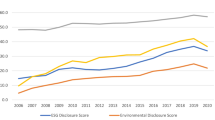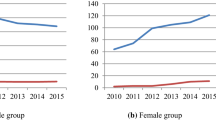Abstract
This study provides insights on sector-specific characteristics, challenges and issues that affect corporate responsibility (CR) in relation to ethnicity and gender on arts boards. Using stakeholder theory, the study explores how arts board composition (e.g. gender and ethnicity) sets the scene for dynamics that affect CR. Data analysis is based on interviews with 92 board members and stakeholders sitting on 66 arts boards in Australia. Results suggest that the dynamism of gender and ethnic diversity on arts boards makes them responsive to CR; however, their presence does not always lead to CR. For diverse boards to lead to CR, our findings indicate the significance of board member attributes of passion, skill and capability of developing networks, irrespective of gender and ethnicity. The article advances understanding of the implications and relevance of ethnic and gender diversity on non-profit boards and contributes to an important yet under-researched body of literature.
Similar content being viewed by others
References
Adams, R., & Ferreira, D. (2009). Women in the boardroom and their impact on governance and performance. Journal of Financial Economics, 94(2), 291–309.
Adams, R.B., Gray, S. & Nowland, J. (2011). Does gender matter in the boardroom? Evidence from the market reaction to mandatory new director announcements. Social Science Research Network. Retrieved November 2, from http://papers.ssrn.com/sol3/papers.cfm?abstract_id=1953152.
Ames, P. (1985). Guiding museum values: Trustees, missions and plans. Museum News, pp. 48–54.
Attorney-General’s Department (2011). Creative industries, a strategy for 21st century Australia. Attorney-General’s Department, Ministry for the Arts, Government of Australia, Retrieved from http://arts.gov.au/creative.
Australian Bureau of Statistics (2009). Not-for-profit Organisations, Australia, 2006–2007 (Re-Issue). ABS, cat. No. 8106.0. Retrieved from http://www.abs.gov.au/ausstats/abs@.nsf/mf/8106.0.
Australian Bureau of Statistics (2011). Cultural diversity in Australia: reflecting a nation: Stories from 2011 census. ABS, cat. No. 2071.0. Retrieved from http://www.abs.gov.au/ausstats/abs@.nsf/mf/2071.0.
Australian Institute of Company Directors (2011). Directors Social Impact Study AICD and Commonwealth Bank of Australia, Sydney.
Ayuso, S., Arino, A. M., & Garcia-Castro, R. (2014). Maximizing stakeholders’ interests: An empirical analysis of the stakeholder approach to corporate governance. Business and Society, 53(3), 414–439.
Azmat, F. (2013). Opportunities or obstacles? Understanding the challenges faced by migrant women entrepreneurs. International Journal of Gender and Entrepreneurship, 5(2), 198–215.
Berry, J. W. (1980). Acculturation as varieties of adaptation. In A. M. Padilla (Ed.), Acculturation: Theories, models and findings. Boulder, CO: Westview Press.
Beschorner, T., Hajduk, T., & Simeonov, S. (2013). Corporate responsibility in Europe: Government involvement in sector-specific initiatives. Gütersloh: Bertelsmann.
Bhimani, A., & Soonawalla, K. (2005). From conformance to performance: The corporate responsibilities continuum. Journal of Accounting and Public Policy, 24(3), 165–174.
Bodenhausen, G. V. (2010). Diversity in the person, diversity in the group: Challenges of identity complexity for social perception and social interaction. European Journal of Social Psychology, 40(1), 1–16.
Brannen, M. Y., & Thomas, D. C. (2010). Bicultural individuals in organizations: Implications and opportunity. International Journal of Cross Cultural Management, 10(1), 5–16.
Brown, W. A., & Guo, C. (2010). Exploring the key roles for nonprofit boards. Nonprofit and Voluntary Sector Quarterly, 39(3), 536–546.
Carroll, A. B., & Shabana, K. M. (2010). The business case for corporate social responsibility: A review of concepts, research and practice. International Journal of Management Review, 12(1), 85–105.
Chapple, L., & Humphrey, Y. J. (2014). Does board gender diversity have a financial impact? Evidence using stock portfolio performance. Journal of Business Ethics, 122(4), 709–723.
Collinson, D. L. (1992). Managing the shop floor: Subjectivity, masculinity and workplace culture. Berlin: Walter De Gruyter.
Cornelius, N., Todres, M., Janjuha-Jivraj, J., Woods, A., & Wallace, J. (2008). Corporate social responsibility and the social enterprise. Journal of Business Ethics, 81(2), 355–370.
Cornforth, C. (2012). Non-profit governance research: Limitations of the focus on boards and suggestions for new directions. Nonprofit and Voluntary Sector Quarterly, 41(6), 1116–1135.
Deloitte (2012). Survey into the Not-for-Profit Sector 2012—Fundraising, Deloitte. Retrieved from https://www.deloitte.com.
Desvaux, G., Devillard, S. & Sancier-Sultan, S. (2010a). Women matter 2010: Women at the top of corporations: Making it happen (pp. 1–22). New York: McKinsey and Company.
Desvaux, G., Devillard, S. & Sancier-Sultan, S. (2010b). Women matter 3: Women leaders, a competitive edge in and after the crisis (pp. 1–22). New York: McKinsey and Company.
Devillard, S., Graven, W., Lawson, E., Paradise, R. & Sancier-Sultan, S. (2012). Women matter 2012: Making the Breakthrough (pp. 1–26). New York: McKinsey and Company.
Dickenson, V. (1991). An inquiry into the relationship between museum boards and management. Curator, 34(4), 291–303.
DiMaggio, P. (1987). Classification in art. American Sociological Review, 52, 440–455.
Du Plessis, J., O’Sullivan, J., & Rentschler, R. (2014). Multiple layers of gender diversity on corporate boards: To force or not to force? Deakin Law Review, 19(1), 1–50.
Emanuele, R., & Higgins, S. H. (2000). Corporate culture in the non-profit sector: A comparison of fringe benefits with the for-profit sector. Journal of Business Ethics, 24(1), 87–93.
Fasick, F. A. (2001). Some uses of untranscribed tape recordings in survey research. Public Opinion Quarterly, 41(4), 549–552.
Fitzsimmons, T. W., Callan, V. J., & Paulsen, N. (2014). Gender disparity in the C-suite: Do male and female CEOs differ in how they reached the top?. Leadership Quarterly, 25(2), 245–266.
Fondas, N. (2000). Women on boards of directors: Gender bias or power threat? In R. J. Burke & M. C. Mattis (Eds.), Women on corporate boards of directors: International challenges and opportunities (pp. 171–178). Dordrecht: Kluwer Academic.
Forbes, D. P., & Milliken, F. J. (1999). Cognition and corporate governance: Understanding boards of directors as strategic decision-making groups. Academy of Management Review, 24(3), 489–505.
Freeman, R. E. (1984). Strategic management: A stakeholder approach. Boston: Pitman.
Golden-Biddle, K., & Rao, H. (1997). Breaches in the boardroom: Organizational identity and conflicts of commitment in a nonprofit organization. Organization Science, 8(6), 593–611.
Griffin, D., & Abraham, M. (2000). The effective management of museums: Cohesive leadership and visitor-focused public programming. Museum Management and Curatorship, 18(4), 335–368.
Hafsi, T., & Turgut, G. (2013). Boardroom diversity and its effect on social performance: Conceptualization and empirical evidence. Journal of Business Ethics, 112(3), 463–479.
Han, J., Han, J., & Brass, D. J. (2014). Human capital diversity in the creation of social capital for team creativity. Journal of Organizational Behaviour, 35(1), 54–71.
Hendry, K., & Kiel, G. C. (2004). The role of the board in firm strategy: Integrating agency and organisational control perspectives. Corporate Governance: An International Review, 12(4), 500–520.
Herman, R. D., & Renz, D. O. (2004). Doing things right: Effectiveness in local non-profit organizations—A local study. Public Administration Review, 64(6), 694–704.
Jamali, D., & Keshishian, T. (2009). Uneasy alliances: Lessons learned from partnerships between businesses and NGOs in the context of CSR. Journal of Business Ethics, 84(2), 277–295.
Jamali, D., Safieddine, A. M., & Rabbath, M. (2008). Corporate governance and corporate social responsibility: Synergies and interrelationships. Corporate Governance: An International Review, 16(5), 443–459.
Johnson, G. S., Schnatterly, K., & Hill, D. A. (2013). Board composition beyond independence social capital, human capital, and demographics. Journal of Management, 39(1), 232–262.
Kendall, E. K., & Kendall, E. J. (2002). Systems analysis and design. Cambridge, MA: MIT Press.
Lincoln, Y. S., & Guba, E. G. (1985). Naturalistic inquiry. Beverly Hills, CA: Sage.
Lindgreen, A., Kotler, P., Maon, F., & Vanhamme, J. (Eds.). (2012). A stakeholder approach to corporate social responsibility: Pressures, conflicts, and reconciliation. Aldershot: Gower.
MacMillan, K., Money, K., Downing, S., & Hillenbrad, C. (2004). Giving your organization SPIRIT: An overview and call to action for directors on issues of corporate governance, corporate reputation and corporate responsibility. Journal of General Management, 30(2), 15–42.
Mason, J. (2002). Qualitative researching (2nd ed.). London: Sage.
McElhaney, K. (2009). Approach to corporate social responsibility. Leader to Leader, 52(1), 30–36.
McWilliams, A., Siegel, D. S., & Wright, P. M. (2006). Corporate social responsibility: Strategic implications. Journal of Management Studies, 43(1), 1–18.
Miles, M. B., & Huberman, A. M. (1994). Qualitative data analysis (2nd ed.). Newbury Park, CA: Sage.
Miller, T., & Triana, M. (2009). Demographic diversity in the boardroom: Mediators of the board diversity–firm performance relationship. Journal of Management Studies, 46(5), 755–786.
Ostrower, F., & Stone, M. M. (2010). Moving governance research forward: A contingency-based framework and data application. Nonprofit and Voluntary Sector Quarterly, 39(5), 901–924.
Patton, M.Q. & Cochran, M. (2002). A guide to using qualitative research methodology. Paris: Médecins Sans Frontières.
Poland, B. D. (1995). Transcription quality as an aspect of rigor in qualitative research. Qualitative Inquiry, 1(3), 290–310.
Porter, M. E., & Kramer, M. R. (2006). Strategy and society: The link between competitive advantage and corporate social responsibility. Harvard Business Review, 85(12), 76–92.
Productivity Commission (2010). Contribution of the Not-for-Profit Sector Research Report. Productivity Commission Research Report, Canberra, Australia.
Radbourne, J. (2003). Performing on boards: The link between governance and corporate reputation in non-profit arts boards. Corporate Reputation Review, 6(3), 1–11.
Reid, W., & Turbide, J. (2012). Board/staff relationships in a growth crisis: Implications for non-profit governance. Nonprofit and Voluntary Sector Quarterly, 40(1), 82–99.
Rentschler, R. (2002). The entrepreneurial arts leader: Cultural policy, change and reinvention. Brisbane: University of Queensland Press.
Rentschler, R. (2015). Arts governance: People, passion, performance. London: Routledge.
Rentschler, R., & Radbourne, J. (2008). Performance and Conformance of Victorian Arts Boards. Melbourne: Report for Arts Victoria.
Rosenthal, L. (2012). Nonprofit Corporate Governance: The Board’s Role. The Harvard Law School Forum on Corporate Governance and Financial Regulations. Retrieved from http://blogs.law.harvard.edu/corpgov/2012/04/15/nonprofit-corporate-governance-the-boards-role/.
Saldana, J. (2008). Coding manual for qualitative researchers. Los Angeles, CA: Sage.
Salt, B. (2014). More indecent obsession. Melbourne: Melbourne University Press.
Sealy, R., Doldor, E. & Vinnicombe, S. (2009). Increasing diversity on public and private sector boards-Part 1. International Centre for Women Leaders, Cranfield School of Management, Government Equalities Office, London.
Sheridan, A., Haslam, F., & Still, L. (2011). Complex and contradictory: The doing of gender on regional development boards. Gender, Work and Organization, 18(3), 282–297.
Stahl, G. K., Maznevski, M. L., Voigt, A., & Jonsen, K. (2010). Unraveling the effects of cultural diversity in teams: A meta-analysis of research on multicultural work groups. Journal of International Business Studies, 41(4), 690–709.
Steane, P., & Christie, M. (2001). Nonprofit boards in Australia: A distinctive governance approach. Corporate Governance: An International Review, 9(1), 48–58.
Syed, J., & Kramar, R. (2009). What is the Australian model for managing cultural diversity? Personnel Review, 39(1), 96–115.
Tadmor, C. T., Tetlock, P. E., & Peng, K. (2009). Acculturation strategies and integrative complexity: The cognitive implications of biculturalism. Journal of Cross-Cultural Psychology, 40(1), 105–139.
Turbide, J., Laurin, C., Lapierre, L., & Morrissette, R. (2008). Financial crises in the arts: Is governance the illness or the cure? International Journal of Arts Management, 10(2), 5–13.
Turner, J. C., & Oakes, P. J. (1989). Self-categorisation theory and social influence. In P. B. Paulus (Ed.), Psychology of group influence (pp. 233–275). Hillsdale, NJ: Lawrence Erlbaum.
Urice, J. (1990). Not-for-profit arts trustees: Report of a national sample. Journal of Cultural Economics, 14(2), 53–71.
Vallerand, R. J., Paquet, Y., Philippe, F. L., & Charest, J. (2010). On the role of passion for work in burnout: A process model. Journal of Personality, 78(1), 289–312.
Van der Walt, N., & Ingley, C. (2003). Board dynamics and the influence of professional background, gender and ethnic diversity of directors. Corporate Governance: An International Review, 11(3), 218–234.
Waddock, S. (2004). Creating corporate accountability: Foundational principles to make corporate citizenship real. Journal of Business Ethics, 50(4), 313–327.
Author information
Authors and Affiliations
Corresponding author
Appendix
Appendix
See Table 3.
Rights and permissions
About this article
Cite this article
Azmat, F., Rentschler, R. Gender and Ethnic Diversity on Boards and Corporate Responsibility: The Case of the Arts Sector. J Bus Ethics 141, 317–336 (2017). https://doi.org/10.1007/s10551-015-2707-0
Received:
Accepted:
Published:
Issue Date:
DOI: https://doi.org/10.1007/s10551-015-2707-0




